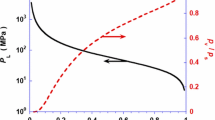Abstract
Tension softening and cracking due to non-uniform shrinkage is investigated in a parametric study and the relation between shrinkage as a material property and the dimensional change of drying specimens is analysed. It is found that regions with tensile strains causing softening or cracking are developed in the early stages of drying. The shrinkage of a drying concrete specimen is always less than or equal to the true material shrinkage, but for normal concrete and drying situations which occur in practice the difference is small compared with the final shrinkage.
Similar content being viewed by others
Abbreviations
- C :
-
Diffusivity with respect to moisture concentration
- E :
-
Elastic modulus
- E T :
-
Softening modulus
- F O :
-
Fourier number (dimensionless time), defined in Equation 1
- l ch :
-
Characteristic length of the material
- l s :
-
Spacing between localized cracking zones
- R :
-
Half-thickness of plate, radius of cylinder
- s :
-
Drying shrinkage in the material corresponding to a moisture change betweenw 0 andw 1
- w :
-
Specific moisture content
- w 0 :
-
Initial value ofw
- w 1 :
-
Value ofw when drying is completed
- x :
-
Position coordinate
- ∈l :
-
Relative length change of cylinder or plate
- ∈p :
-
Strain at maximum tensile stress (see Fig. 3)
- ∈s :
-
Shrinkage strain
- \(\bar \in _s \) :
-
‘Mean’ free shrinkage
- θ:
-
Dimensionless water content, defined in Equation 1
- ξ:
-
x/R, dimensionless position coordinate
- σe :
-
Stress due to external load
References
Bazant, Z. P., ‘Mathematical models for creep and shrinkage of concrete’, in ‘Creep and Shrinkage in Concrete Structures’, edited by Z. P. Bazant, F. H. Wittman (Wiley, London, 1982).
Wittman, F. H., ‘Creep and shrinkage mechanisms’, in ‘Creep and Shrinkage in Concrete Structures’, edited by Z. P. Bazant and F. H. Wittman (Wiley, London, 1982).
Wittman, F. H. and Roelfstra, P. E., ‘Total deformation of loaded drying concrete’,Cem. Concr. Res. 10 (1980) 601–610.
Bazant, Z. P. and Raftshol, W. J., ‘Effect of cracking in drying and shrinkage specimens’,ibid. 12 (1982) 209–226.
Day, R. L., Cuffaro, P. and Illston, J. M., ‘The effect of rate of drying creep on the drying of hardened cement paste,ibid. 14 (1984) 329–338.
Hwang, C. L. and Young, J. F., ‘Drying shrinkage of Portland cement pastes. I. Microcracking during drying’,ibid. 14 (1984) 585–594.
Roelfstra, P. E., ‘Numerical simulation of time-dependent deformations under hygral och thermal transient conditions’, in Transactions of SMIRT-9, Lausanne, 1987, Vol. H, (A. A. Balkema, Rotterdam 1987). pp. 83–102.
Bazant, Z. P. and Chern, J. C., ‘Concrete creep at variable humity: Constitutive law and mechanism’,Mater. Struct. 18 (1985) 1–20.
Bazant, Z. P., Asghari, A. A. and Schmidt, J., ‘Experimental study of creep of hardened Portland cement paste at variable water content’,ibid. 9 (1976) 279–290.
Pickett, G. ‘The effect of change in moisture content on the creep of concrete under sustained load’,J. Amer. Concr. Inst. 38 (1942) 333–355.
Ali, I. and Kesler, C., ‘Mechanisms of creep in concrete’, ACI Special Publication SP09 (1964) (American Concrete Institute, Detroit, 1964). pp. 35–37.
Brooks, J. J. and Neville, A. M., ‘A comparison of creep elasticity and strength of concrete in tension and in compression’,Mag. Concr. Res. 29 (100) (1977) 131–141.
Gamble, B. R. and Parrott, L. J., ‘Creep of concrete in compression during drying and wetting’,ibid. 30 (104) (1978) 129–138.
Thelandersson, S. and Mårtensson, A., ‘Effect of Tension Softening and Cracking on Drying Shrinkage of Concrete’, Report TVSM-7041 (Division of Structural Mechanics, Lund University, Lund, 1987).
Hillerborg, A., Modeer, M. and Petersson, P. E., ‘Analysis of crack formation and crack growth in concrete by means of fracture mechanics and finite elements’,Cem. Concr. Res. 6 (1976) 778–782.
Gustafsson, P. J., ‘Fracture Mechanics Studies of Nonvielding Materials like Concrete’, Report TVBM-1007 (Division of Building Materials, Lund Institute of Technology, Lund, 1985).
Bazant, Z. P. and Oh, B. H., ‘Crack band theory for fracture of concrete’,Mater. Struct. 16 (1983) 155–177.
Bazant, Z. P., ‘Mechanics of distributed cracking’,Appl. Mech. Rev. 39 (5) (1966) 675–705.
Bazant, Z. P. and Ohtsubo, H., ‘Stability conditions for propagation of a system of cracks in a brittle solid’,Mech. Res. Commun. 4 (5) (1977) 353–366.
Dahlblom, O., ‘Constitutive modelling and finite element analysis of concrete structures with regard to environmental influence’, Report TVSM-1004 (Division of Structural Mechanics, Lund University, Lund, 1987).
Reinhardt, H. W., ‘Fracture mechanics of an elastic softening material like concrete’,Heron 29 (2) (1984).
Author information
Authors and Affiliations
Rights and permissions
About this article
Cite this article
Thelandersson, S., Mårtensson, A. & Dahlblom, O. Tension softening and cracking in drying concrete. Materials and Structures 21, 416–424 (1988). https://doi.org/10.1007/BF02472321
Issue Date:
DOI: https://doi.org/10.1007/BF02472321




